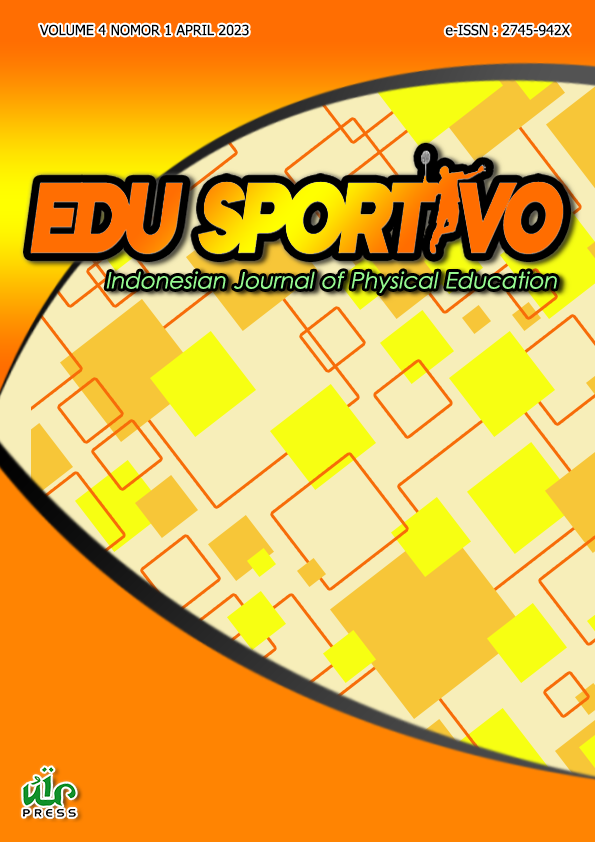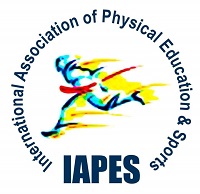Students’ dance performances and the utilization of e-materials in physical education
Keywords:
E-materials, physical education, students’ dance performance, descriptive-quantitative methodAbstract
As a result of the Covid-19 virus, which has affected everyone, the educational community is in a tough situation right now. Technology's advancement in the teaching-learning instruction process is both a benefit and a drawback of globalization's educational approach. The study was primarily concerned with how the use of e-materials in the classroom might increase students' learning performance in physical education dancing. This study was a correlational investigation of 50 grade 9 students' dance performances and the utilization of e-materials in physical education in Sta. Catalina National High School, Candelaria, Quezon. The research was conducted using a descriptive-quantitative technique and a self-administered questionnaire through Google Form. The findings demonstrated that the use of e-materials in physical education dancing is always noted, and students' performance improves significantly when e-materials are used. Furthermore, there is no relationship between e-materials used to teach dance in physical education and student dance performance. It encouraged students to keep using and employing the effectiveness of e-materials in their dancing performances. This research will help to understand how effective the use of e-materials is in teaching dance in physical education and how it affects student performance and will provide valuable insights on the best practices for teaching dance in physical education and how to maximize the use of e-materials to enhance student performance.
Downloads
References
Al-Azawei, A., Parslow, P., & Lundqvist, K. (2016). Barriers and opportunities of e-learning implementation in Iraq: A case of public universities. International Review of Research in Open and Distance Learning, 17(5), 126–146. https://doi.org/10.19173/irrodl.v17i5.2501 DOI: https://doi.org/10.19173/irrodl.v17i5.2501
Amineh, R. J., & Asl, H. D. (2015). Review of constructivism and social constructivism. Journal of Social Sciences, Literature and Languages, 1(1), 9–16. http://blue-ap.org
Anam, B. (2019). Skills for 21st century teachers.
Aquino, J. M. (2022). Students’ evaluation in the developed video-based learning materials for physical education in Higher Education Institutions (HEIs). Edu Sportivo: Indonesian Journal of Physical Education, 111–124. https://doi.org/10.25299/es:ijope.2022.vol3(2).9428 DOI: https://doi.org/10.25299/es:ijope.2022.vol3(2).9428
Cortez, C. P. (2020). Blended, Distance, Electronic and Virtual-Learning for the New Normal of Mathematics Education: A Senior High School Student’s Perception. European Journal of Interactive Multimedia and Education, 1(1), e02001. https://doi.org/10.30935/ejimed/8276 DOI: https://doi.org/10.30935/ejimed/8276
Culajara, C. J. (2022). The impact of video-based presentations on BPED students’ learning performance. Edu Sportivo: Indonesian Journal of Physical Education, 3(2), 137–148. https://doi.org/10.25299/es:ijope.2022.vol3(2).9418 DOI: https://doi.org/10.25299/es:ijope.2022.vol3(2).9418
El-Ariss, B., Zaneldin, E., & Ahmed, W. (2021). Using videos in blended e-learning for a structural steel design course. Education Sciences, 11(6). https://doi.org/10.3390/educsci11060290 DOI: https://doi.org/10.3390/educsci11060290
El-Raheb, K., Stergiou, M., Katifori, A., & Ioannidis, Y. (2019). Dance interactive learning systems: A study on interaction workflow and teaching approaches. ACM Computing Surveys, 52(3), 1–37. https://doi.org/10.1145/3323335 DOI: https://doi.org/10.1145/3323335
Fisher, D., & Frey, N. (2014). Checking for understanding: Formative assessment techniques for your classroom. ASCD.
Gilakjani, A. P., Lai-Mei, L., & Ismail, H. N. (2013). Teachers' use of technology and constructivism. International Journal of Modern Education and Computer Science, 5(4), 49-63. https://doi.org/10.5815/ijmecs.2013.04.07 DOI: https://doi.org/10.5815/ijmecs.2013.04.07
Goh, C. F., Hii, P. K., Tan, O. K., & Rasli, A. (2020). Why do University teachers use e-learning systems? International Review of Research in Open and Distance Learning, 21(2), 136–155. https://doi.org/10.19173/irrodl.v21i2.3720 DOI: https://doi.org/10.19173/irrodl.v21i2.3720
Harandi, S. R. (2015). Effects of e-learning on Students’ Motivation. Procedia - Social and Behavioral Sciences, 181, 423–430. https://doi.org/10.1016/j.sbspro.2015.04.905 DOI: https://doi.org/10.1016/j.sbspro.2015.04.905
Johnson, B. S. (2021). Checking for Understanding. Better Questioning for Better Learning, 201–206. https://doi.org/10.4324/9781003175674-23 DOI: https://doi.org/10.4324/9781003175674-23
Joseph, S., Thomas, M., Simonette, G., & Ramsook, L. (2013). The Impact of Differentiated Instruction in a Teacher Education Setting: Successes and Challenges. International Journal of Higher Education, 2(3), 28–40. https://doi.org/10.5430/ijhe.v2n3p28 DOI: https://doi.org/10.5430/ijhe.v2n3p28
Lu, C., Barrett, J., & Lu, O. (2020). Teaching physical education teacher education (PETE) online: Challenges and solutions. Brock Education Journal, 29(2), 13. https://doi.org/10.26522/brocked.v29i2.828 DOI: https://doi.org/10.26522/brocked.v29i2.828
Muñoz-Carril, P. C., Sanmamed, M. G., & Hernández Sellés, N. (2013). Pedagogical roles and competencies of university teachers practicing in the E-learning environment. International Review of Research in Open and Distance Learning, 14(3), 462–487. https://doi.org/10.19173/irrodl.v14i3.1477 DOI: https://doi.org/10.19173/irrodl.v14i3.1477
Naveed, Q. N., Muhammed, A., Sanober, S., Qureshi, M. R. N., & Shah, A. (2017). Barriers effecting successful implementation of E-learning in Saudi Arabian Universities. International Journal of Emerging Technologies in Learning, 12(6), 94–107. https://doi.org/10.3991/ijet.v12i06.7003 DOI: https://doi.org/10.3991/ijet.v12i06.7003
Nesterchuk, N., Grygus, I., Ievtukh, M., Kudriavtsev, A., & Sokołowski, D. (2020). Impact of the wellness program on the quality of life of students. Journal of Physical Education and Sport, 20(2), 929–938. https://doi.org/10.7752/jpes.2020.s2132 DOI: https://doi.org/10.7752/jpes.2020.s2132
Rabe, K. F., & Watz, H. (2017). Chronic obstructive pulmonary disease. The Lancet, 389(10082), 1931–1940. https://doi.org/10.1016/S0140-6736(17)31222-9 DOI: https://doi.org/10.1016/S0140-6736(17)31222-9
Ranieri, M., Raffaghelli, J., & Pezzati, F. (2018). Digital resources for faculty development in e-learning: a self-paced approach for professional learning. Italian Journal of Educational Technology, 26(1), 104-118.
Rekola, S., & Savo, K. (2018). Using Electronic Materials in The Efl Classroom: 8th Graders’ Views on The Motivational Aspect of E-Materials. University of Jyväskylä.
Scheg, A. G. (2014). Reforming teacher education for online pedagogy development. Reforming Teacher Education for Online Pedagogy Development, 1–316. https://doi.org/10.4018/978-1-4666-5055-8 DOI: https://doi.org/10.4018/978-1-4666-5055-8
Schmid, R. F., Bernard, R. M., Borokhovski, E., Tamim, R. M., Abrami, P. C., Surkes, M. A., Wade, C. A., & Woods, J. (2014). The effects of technology use in postsecondary education: A meta-analysis of classroom applications. Computers & Education, 72, 271–291. https://doi.org/10.1016/J.COMPEDU.2013.11.002 DOI: https://doi.org/10.1016/j.compedu.2013.11.002
Sekaran, Holliday, C. O. J., Schmidheiny, S., Watts, P., Schmidheiny, S., Watts, P., Montgomery, H., Pmi, University of Pretoria, Gentry, R. R., Lester, S. E., Kappel, C. V., White, C., Bell, T. W., Stevens, J., Gaines, S. D., Zavadskas, E. K., Cavallaro, F., Podvezko, V., … Branch, B. (2018). No. Pakistan Research Journal of Management Sciences, 7(5), 1–2.
Shi, Y. R., & Shih, J. L. (2015). Game Factors and Game-Based Learning Design Model. International Journal of Computer Games Technology, 2015, 1–11. https://doi.org/10.1155/2015/549684 DOI: https://doi.org/10.1155/2015/549684
Sööt, A., & Viskus, E. (2014). Teaching Dance in the 21st Century: A Literature Review. The European Journal of Social & Behavioural Sciences, 7(4), 624–640. https://doi.org/10.15405/EJSBS.99 DOI: https://doi.org/10.15405/ejsbs.99
Suryawan, A. I., Mariah, Y. S., & Dyani, P. L. (2022). Improving Creativity Through Development of Dance Learning Models for Teachers in Junior High Schools in Bandung. Proceedings of the 4th International Conference on Arts and Design Education (ICADE 2021), 665(Icade 2021), 8–11. https://doi.org/10.2991/assehr.k.220601.003 DOI: https://doi.org/10.2991/assehr.k.220601.003
Sweeney, S. M., Hemler, J. R., Baron, A. N., Woodson, T. T., Ono, S. S., Gordon, L., Crabtree, B. F., & Cohen, D. J. (2020). Dedicated workforce required to support large-scale practice improvement. Journal of the American Board of Family Medicine, 33(2), 230–239. https://doi.org/10.3122/jabfm.2020.02.190261 DOI: https://doi.org/10.3122/jabfm.2020.02.190261
Tarus, J. K., Gichoya, D., & Muumbo, A. (2015). Challenges of implementing E-learning in Kenya: A case of Kenyan public universities. International Review of Research in Open and Distance Learning, 16(1), 120–141. https://doi.org/10.19173/irrodl.v16i1.1816 DOI: https://doi.org/10.19173/irrodl.v16i1.1816
Tîrziu, A.-M., & Vrabie, C. (2015). Education 2.0: E-Learning Methods. Procedia - Social and Behavioral Sciences, 186, 376–380. https://doi.org/10.1016/j.sbspro.2015.04.213 DOI: https://doi.org/10.1016/j.sbspro.2015.04.213
Vahtivuori-hanninen, S., Halinen, I., Niemi, H., & Lavonen, J. (2014). Finnish Innovations and Technologies in Schools. Finnish Innovations and Technologies in Schools, January 2014. https://doi.org/10.1007/978-94-6209-749-0 DOI: https://doi.org/10.1007/978-94-6209-749-0
Vitoria, L., Mislinawati, M., & Nurmasyitah, N. (2018). Students’ perceptions on the implementation of e-learning: Helpful or unhelpful? Journal of Physics: Conference Series, 1088. https://doi.org/10.1088/1742-6596/1088/1/012058 DOI: https://doi.org/10.1088/1742-6596/1088/1/012058
Windiarti, S., Fadilah, N., Dhermawati, E., & Pratolo, B. W. (2019). Teachers’ Perception toward the Obstacles of E-Learning Classes. Ethical Lingua: Journal of Language Teaching and Literature, 6(2), 117–128. https://doi.org/10.30605/25409190.v6.117-128 DOI: https://doi.org/10.30605/25409190.v6.117-128
Zhao, P., Sintonen, S., & Kynäslahti, H. (2015). The Pedagogical Functions of Arts and Cultural-Heritage Education with in Online Art Galleries and Musuems. International Journal of Heritage in the Digital Era, 4(1), 103–120. https://doi.org/10.1260/2047-4970.4.1.103 DOI: https://doi.org/10.1260/2047-4970.4.1.103
Published
How to Cite
Issue
Section
This is an open-access article distributed under the terms of the Creative Commons Attribution-ShareAlike 4.0 International License which permits unrestricted use, distribution, and reproduction in any medium. Users are allowed to read, download, copy, distribute, search, or link to full-text articles in this journal without asking by giving appropriate credit, provide a link to the license, and indicate if changes were made. All of the remix, transform, or build upon the material must distribute the contributions under the same license as the original.
Accepted 2023-02-26
Published 2023-04-16



.png)




















.png)







.png)





